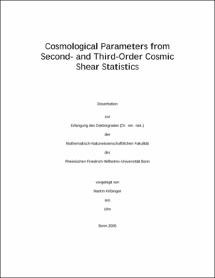Cosmological Parameters from Second- and Third-Order Cosmic Shear Statistics

Cosmological Parameters from Second- and Third-Order Cosmic Shear Statistics

| dc.contributor.advisor | Schneider, Peter | |
| dc.contributor.author | Kilbinger, Martin | |
| dc.date.accessioned | 2020-04-08T20:07:08Z | |
| dc.date.available | 2020-04-08T20:07:08Z | |
| dc.date.issued | 2006 | |
| dc.identifier.uri | https://hdl.handle.net/20.500.11811/2586 | |
| dc.description.abstract | The weak gravitational lensing effect caused by the large-scale structure of the matter in the Universe (cosmic shear) is a powerful tool to study the matter distribution on very large scales. Cosmic shear surveys provide high-precision measurements of the large-scale distribution of matter in the Universe and yield valuable information about cosmology. In this thesis I study the efficacy of cosmic shear statistics to constrain cosmological parameters. In the first part of this work, different strategies of shear surveys are considered and their influence on the measurement accuracy of cosmological parameters is investigated. From Monte-Carlo simulations, the covariance of second-order shear statistics, in particular the aperture mass dispersion <Map2>, is obtained. The covariance encodes the measurement errors and correlations between different angular scales which depend on the survey design. Using the Fisher information matrix, Karhunen-Loève eigenmodes and likelihood techniques, various survey settings are compared with the result that a rigorous sampling on medium and large angular scales is more important than a small cosmic variance. By appropriately choosing the survey geometry a 25 percent improvement on the 1s-errors on cosmological parameters is possible. The second part of this thesis presents predictions of the improvement of constraints on cosmological parameters by combining second- and third-order aperture mass statistics of cosmic shear. The three-point correlation function and the third-order aperture mass statistics are calculated from theoretical non-linear models of structure formation. These predictions are tested and compared with ray-tracing simulations. The dependence of the third-order aperture mass statistics with respect to cosmological parameters is discussed and a two-dimensional visualization of the shear three-point correlation function is presented. After this preparatory work, the second- and third-order aperture mass statistics, <Map2> and <Map3>, are combined to reduce near-degeneracies between cosmological parameters and to improve the resulting error bars. From ?CDM ray-tracing simulations, the covariance and the cross-correlation of <Map2> and <Map3> are estimated. A Fisher matrix analysis shows that the combination of second- and third-order statistics can partially lift the parameter degeneracies, e.g. between Ωm and σ8. The resulting error bars on all considered cosmological parameters are reduced by a factor of 10. | |
| dc.language.iso | eng | |
| dc.rights | In Copyright | |
| dc.rights.uri | http://rightsstatements.org/vocab/InC/1.0/ | |
| dc.subject | cosmology | |
| dc.subject | cosmic shear | |
| dc.subject | third-order statistics | |
| dc.subject.ddc | 520 Astronomie, Kartografie | |
| dc.title | Cosmological Parameters from Second- and Third-Order Cosmic Shear Statistics | |
| dc.type | Dissertation oder Habilitation | |
| dc.publisher.name | Universitäts- und Landesbibliothek Bonn | |
| dc.publisher.location | Bonn | |
| dc.rights.accessRights | openAccess | |
| dc.identifier.urn | https://nbn-resolving.org/urn:nbn:de:hbz:5N-06971 | |
| ulbbn.pubtype | Erstveröffentlichung | |
| ulbbnediss.affiliation.name | Rheinische Friedrich-Wilhelms-Universität Bonn | |
| ulbbnediss.affiliation.location | Bonn | |
| ulbbnediss.thesis.level | Dissertation | |
| ulbbnediss.dissID | 697 | |
| ulbbnediss.date.accepted | 09.12.2005 | |
| ulbbnediss.fakultaet | Mathematisch-Naturwissenschaftliche Fakultät | |
| dc.contributor.coReferee | Schmid-Burgk, Johannes |
Dateien zu dieser Ressource
Das Dokument erscheint in:
-
E-Dissertationen (4120)




